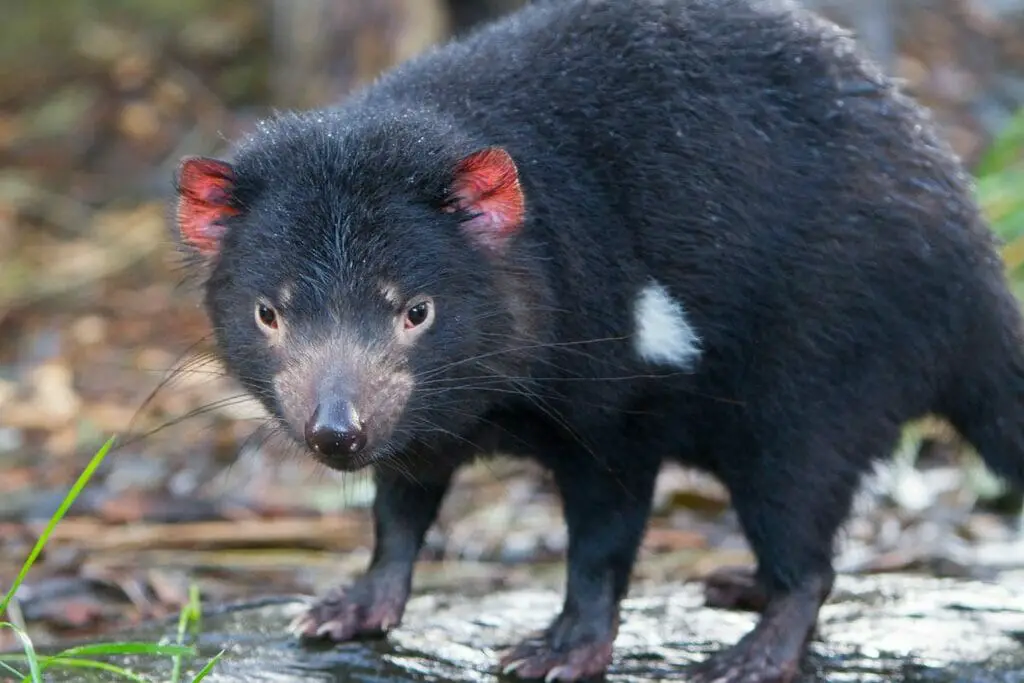Tasmanian devils are an unusual, temperamental, yet loveable creature in the animal kingdom, and have secured a special place in the hearts and minds of animal lovers everywhere thanks to their distinct look, behavior, and quirks.

One such quirk is when their ears turn a reddish hue. But why exactly does this happen, and what does it mean?
The Ears Of The Tasmanian Devil
The fact that Tasmanian devils ears turn red is certainly strange on the face of it, but there are specific reasons why this happens.
The main reason why their ears turn red is due to the flushing of their skin – something that mainly occurs when two Tasmanian devils get into a dispute or confrontation.
This signals that they are either flustered or enraged, so if you see a Tasmanian devil that has ears like this, you are probably best keeping your distance.
What Does This Indicate?
This is used as a means of establishing the prowess of the particular devil, and can be used to avoid conflict just as much as it can be used to elicit it.
Tasmanian devils will usually accompany this reddened skin with a puffed out chest, and the widening of their impressive, powerful jaws as wide as possible to instill fear and submission in the opposing devil.
If this doesn’t work, they can then release a potent, unpleasant odor, the strength of which is enough to send most creatures packing – or at least the ones with a sense of smell.
What Are The Benefits?
In many ways, there are several benefits of this behavior, at least to the devil displaying it. The main benefit is that, if the other devil is sufficiently scared of this behavior, then it could potentially avoid conflict.
Similar behavior happens all throughout the animal kingdom, and is how dominance hierarchies are continually formed.
It even happens among humans, particularly men, who are prone to displays of aggression and strength as a means of establishing themselves as leaders of their peers.
The establishment of dominance, at least within the devil community, comes with perks too, often granting the successful devil the pick of the best food, habitat areas, and female Tasmanian devils.
This might seem primitive, but they are animals we are talking (see also: Animals That Talk)about – and all throughout the animal kingdom, as in the kingdoms of humans, this behavior appears to be one that is deeply coded within our DNA, and is how hierarchic structures are generally formed.
Granted, we might now use more civilized methods, but the essential outcome is the same, which shows that we have changed very little – at least when it comes to getting what we want or need.
How Do They Make Them Turn Red?
This is generally an involuntary reaction, and happens when they become agitated, threatened, or when they are challenged by a rival devil.
As far as we know, this isn’t a conscious action, more of a specific consequence of them becoming emotionally heightened.
The other elements, such as puffing out their chests, and opening their jaws wide are conscious though, and are used to show their prowess and strength.
Are Tasmanian Devils Aggressive?

It is no surprise that Tasmanian devils have developed a reputation for being temperamental and even aggressive.
I’m sure we are familiar with Taz, the Looney Tunes character whose screaming, cyclone-like fury, and voracious appetite made him a household name, and while this is a satirized version of the real devils, it isn’t that far from the truth.
Their natural sounds often involve a distinct scream, as well as hissing, and a guttural growling sound, which can often create the impression of a much larger, more fearsome creature when heard in the distance.
What’s more, their sharp teeth, claws, and confrontational natures have made them more feared than perhaps their initial size and appearance would suggest.
Should They Be Feared?
However, despite their outward appearance, and the way they present themselves and communicate, most Tasmanian devils are quite placid, solitary creatures who would much rather flee or freeze instead of biting a predator.
And while this doesn’t for one moment mean that they wouldn’t bite, it does suggest that the extent of their reputation is just that – reputation.
Generally speaking, it is not beneficial for smaller animals to throw their weight around – after all this draws the attention of predators – and all the Tasmanian devil really wants to do is eat, rest, and play with their peers.
The main source of confrontation for most devils would undoubtedly be with other devils, and this is a natural part of their competitive hierarchic lifestyle.
Are They Dangerous To Humans?
As a rule, Tasmanian devils do not pose significant threats to human beings, although they are more than capable of delivering a nasty bite to those who either get too close, or who pose a large enough threat.
They have some of the most powerful jaws for a creature their size, which means they can not only tear the flesh of humans, but can remove chunks of matter if they get a sufficient grip.
However, if treated with respect, distance, and care, there is no reason why a Tasmanian devil would consciously attack a human being – unless it gave the creature a reason.
Are They Dangerous To Pets?
Pets on the other hand can be at risk of injury if they tangle with a Tasmanian devil.
Dogs and domestic cats are naturally inquisitive creatures, which means it is incredibly important for owners to keep a close eye on them – particularly if you are walking in the habitats usually inhabited by Tasmanian devils.
While most devils are more likely to flee at the sight of a dog – especially a large dog – it only takes one brave, (see also: Animals That Are Brave)defiant devil, and a clear shot with those jaws to do some real, life threatening damage to your faithful hound.
So Is It All Just Hot Air?
Yes and no.
While Tasmanian devils will often keep themselves to themselves, even fleeing at the sign of trouble, they are more than capable of causing injury and defending themselves from predators – and often have sufficient inclination to do so if provoked.
It is certainly true that they can be ‘cranky’ – at least as far as animals go – and while this does not necessarily equate to imminent danger, it does suggest that they are more than ready to dish out some damage if they are forced.
This means that respect is the name of the game – especially given their status as endangered.
Final Thoughts
And there we have it, everything you need to know about the Tasmanian devil, and why it’s ears turn red on occasion.
The Tasmanian devil is a remarkable creature, and one that has suffered in recent decades due to overhunting, disease, and predators.
But hopefully, with a greater understanding of the creatures will come a greater appreciation, and then maybe, just maybe, we can take steps to ensure that they remain a part of the animal kingdom for many more years to come.








